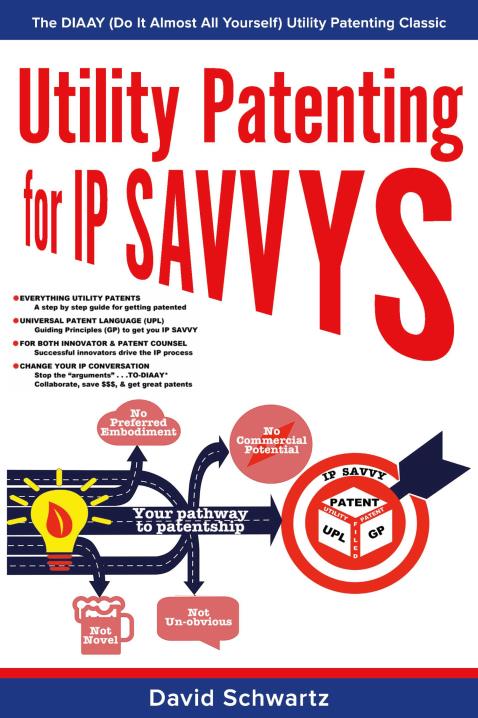IP SAVVYS Blog - select posts by role/title or by category
3 Steps to change your utility patenting conversations and save upwards of 70% of your previous patent spend

If you’re reading this blog post, you are probably engaged in the utility patent quest. When you seek to optimize your sequence of steps for getting a patent filed and publishing with a notice of allowance on the broadest claim for your best mode preferred embodiment, all in the shortest period of time, at the lowest cost, and with the cleanest file wrapper…you’ve come to the right place to find out how.
If you haven’t heard about the proven Schwartz Method for utility patent drafting, filing, and prosecution, it’s time you made a prompt and effective evaluation. This blog post will get you started in that process and put you on your pathway to patentship.
Here are the 3 STEPS you will want to explore in short order. Before I share them, be sure that if you want to go down this learning curve in less than 4 hours, the IP SAVVY educational framework provides a way to achieve that goal and improve your prospects and outcomes. The things you will need to do are :
(1) Get firmly grounde...
Why adopt TSM now-Publishing impact patents at the lowest cost

After you've spent thousands of dollars on a patent application and three times as much on prosecution, the last thing you want is for your invention to be forced into abandonment or to receive a notice of allowance on a weak patent with diminished claims. I’ve now developed a method that can enable you to change your conversations with innovator, counsel, and the patent examiner, achieve your patent objectives, and save more than 70% on your prior patent spend.
After 30 years as a serial innovator, inventor, and pro se patent holder (with 25 patents under my belt), I’ve turned my experience into a book, Utility Patenting for IP SAVVYS, as well as a complementary, self-paced instructional course, Intellectual Property BoostCamp (IP-BC). Each of the tools deliver what I call “The Schwartz Method (TSM),” a promise to streamline the patenting process while saving you big bucks.The book and course offer clear conversations focused on substantive patenting ta...
Video introduction IP SAVVYS Book: Get your utility patenting questions answered in one read
Take a quick listen to this 1 minute introduction to my new book. Read this quick summary. Then move ahead with IP SAVVYS. You can start your "patenting-refocus" and boost your utility patenting capabilities by getting a copy of my new book Utility Patenting for IP SAVVYS. Just set aside 4 hours and read this book in one sitting. Use it as a stand alone resource or allow it to open your horizons and take the IP-BC on-line course to expand your knowledge and functional patenting skills. Share the book and course with your entire team and allow each of the players in the IP hunt to establish their preferred role and align together on IP goals and objectives. Even though each participant may have different goals, instead of competing, use IP SAVVYS to align and collaborate. Change your IP conversation today. Use the Full Starter-Kit to get a download of the compete book, a discount on the eBook, and a bulk discount on the soft cover book.
Common Misconceptions 3: Only the Shaman Patent Counsel can and should write the first claim...or Schwartz's ABC rule
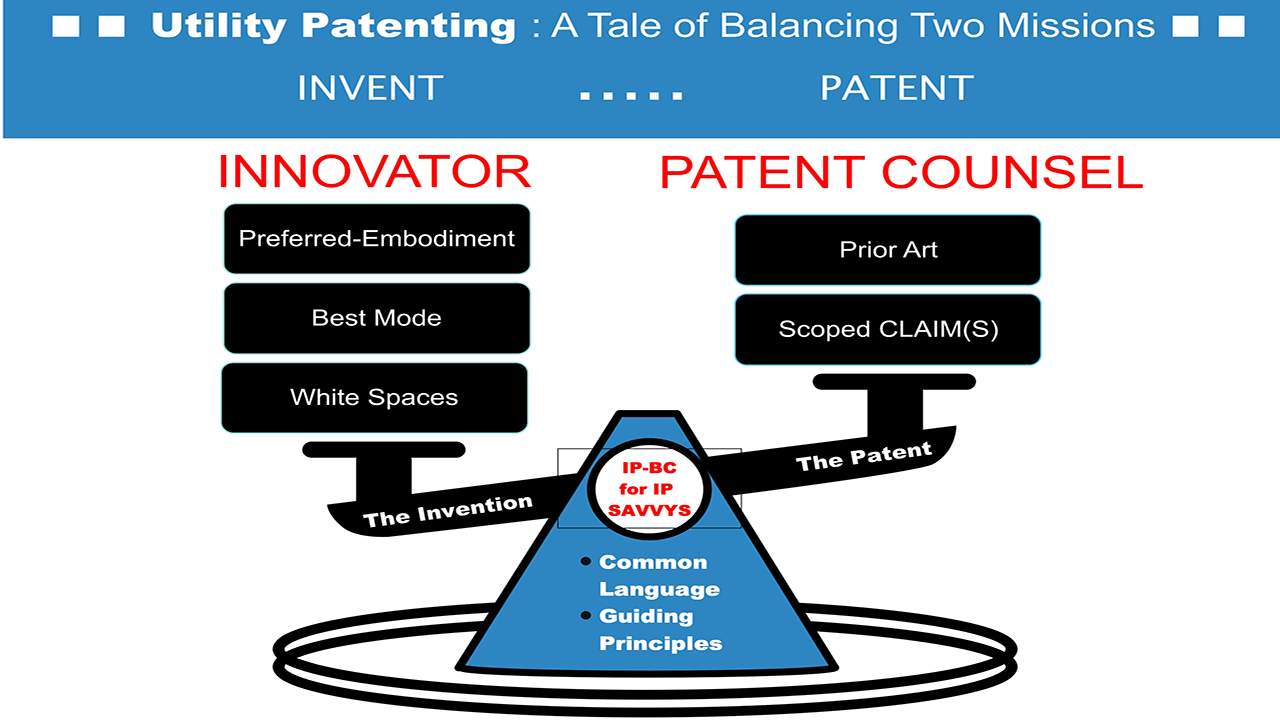
Yes and NO (I repeat NO NO NO :)). Why am I saying this and what do I really mean? What is the Schwartz ABC rule? (explained shortly-it stands for Always Be Claiming).
The yes part is important to state up front. When you file your patent application, my guidance is that the timely completed draft application along with a review and editing of the independent claims be done by a competent patent counsel in your field of art (if they haven't already engaged in a lot more of the crafting/drafting work by that time). In other words, if you engage patent counsel early or alternatively later on... deferring by creating IDPAW entries in preparation for a utility compliant patent application invention disclosure to counsel, you will want to have their claim language and grammar editing (hahaha but seriously even though each claim is a run-on sentence, it has a semantic format that is nuanced by MPEP rules), before filing.
Then why do I admonish NONONO? In the Intellectual Property BoostCam...
Original Misconceptions: 2. Hand over an Invention Disclosure instead of a Schwartz Method Utility Compliant Disclosure (UCD)
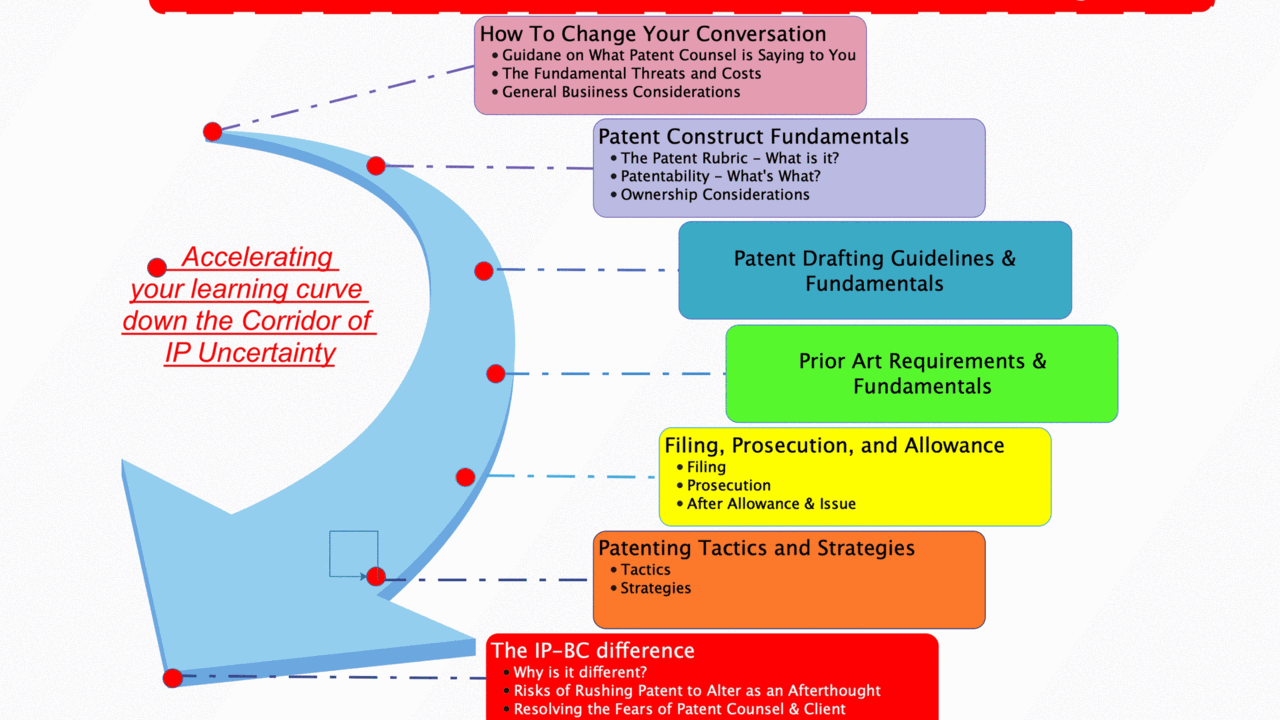
When engaging outside counsel to assist you in the process of preparing and filing a patent, you will always be asked to submit an invention disclosure document as part of the work flow. Often, you will be asked for this "early" as possible in the counsel's project plan since this is the basis for the drafting of a preliminary patent application. The invention disclosure will elicit an array of content components starting with the title of your invention, the inventors, the background and field of art, and so forth. It all seems perfectly logical...how can you ask counsel to work on a patent draft if you don't give them "the goods".
That said, it is a common misconception that you MUST give them the invention disclosure EARLY. In fact, if you have a proper internal utility patenting workflow, not only will you be keeping your invention as a trade secret until the time you choose, but you will also be developing an internal form of invention disclosure as part of your product develop...
The primary reason patents get filed without being de-risked for FOARs
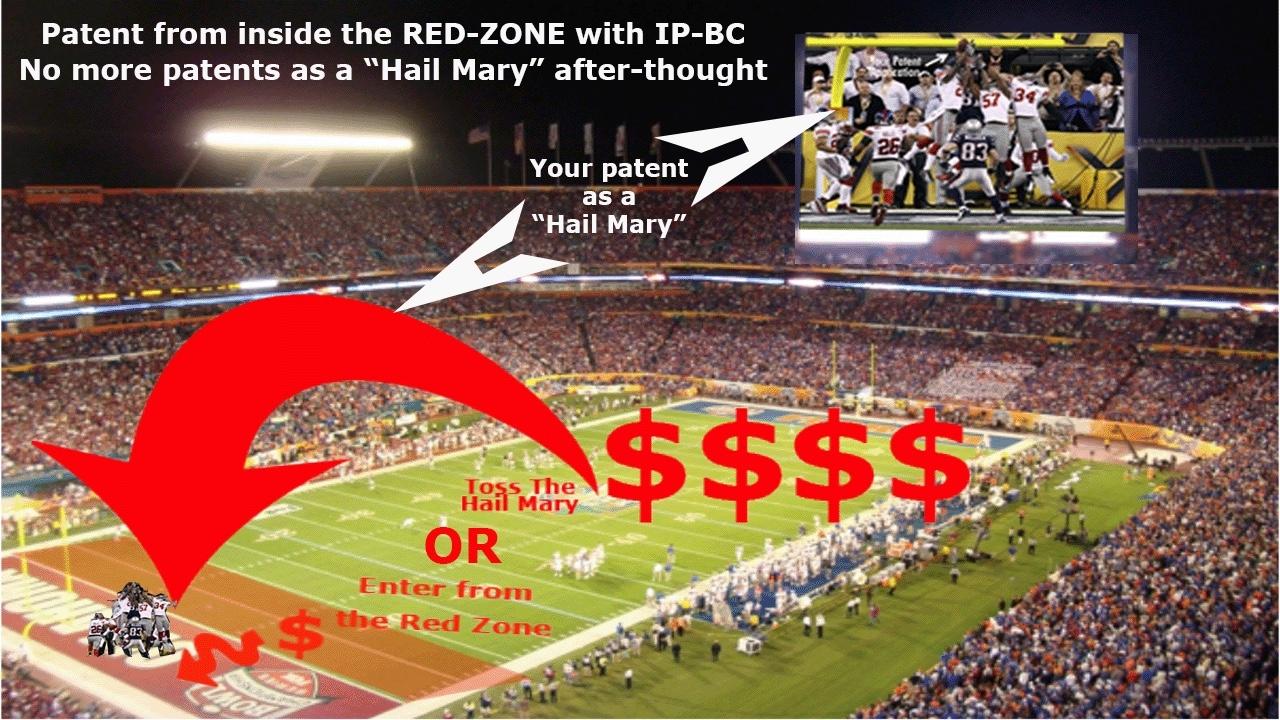
We've covered the race track metaphor as a way to explain the nature of FOARs which can occur with even bonafide patent applications filed with the greatest of intent. But how can this happen with a team of dedicated IP professionals? And why do we use the "Hail Mary" metaphor to describe what this type of IP workflow looks like?
A patent application that is drafted and filed under time pressure, due to internal deadlines or 1 year rule restrictions has the greatest risk of carrying potentially Fatal Office Action Rejections (FOARs) in it's DNA. There are many reasons why this pressured delivery is part of the process and none of them are good reasons or excuses for allowing this to happen. If patent drafting is not part of the product development roadmap, then you and your team is susceptible to this ill fated situation. It is important to understand the symptoms of this in your IP workflow and to Use TSM and BBT to rework your IP sequence of events so that the patent application is ...
Myth #1-Common Misconceptions about IP Capitalization
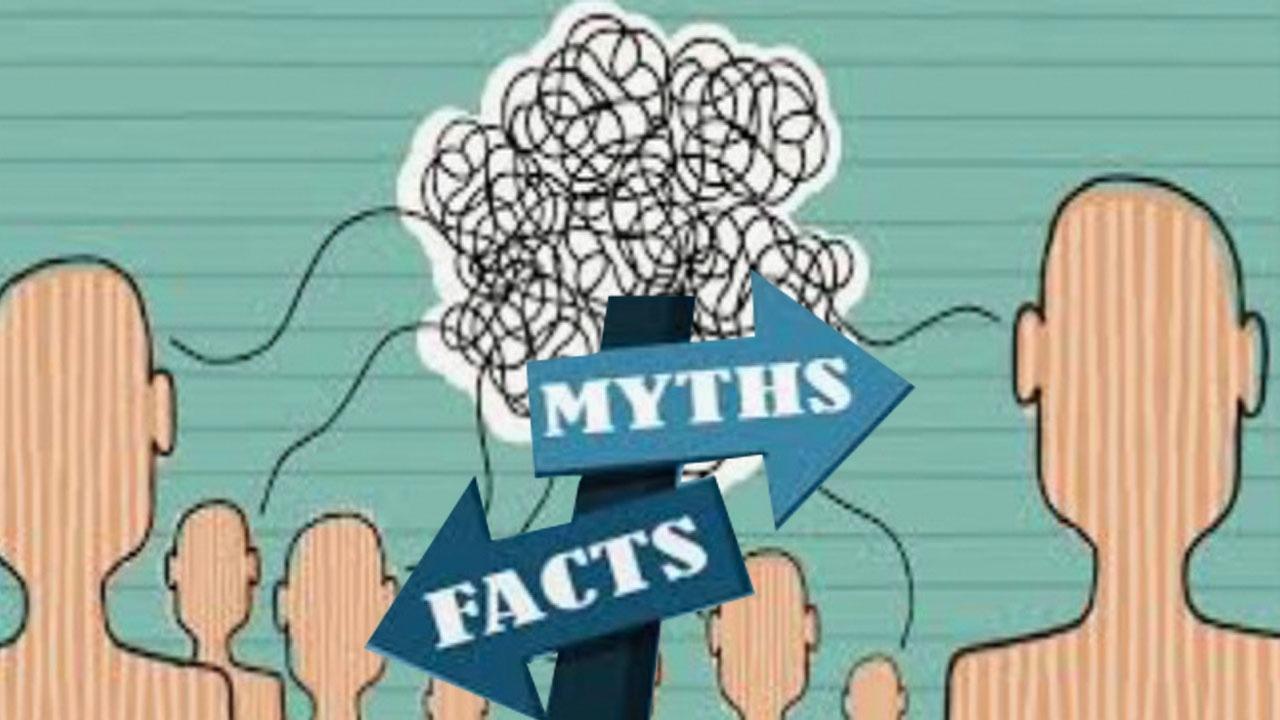
Is it possible that people so smart they are seeking Intellectual Property protection, could have even the inkling of a misconception about getting the right kind of protection?
Of course it is...because it's complicated. This is the perfect use case for "what's easy is hard, and what's hard can be easier". It's easy to say we're getting Ip protection but we know that is very challenging at the least. So if it's really hard, it can be easier with 20/20 hindsight and 80 more IP-IQ points...if you have some clarifications and guidance from a trustworthy source.
Welcome to this category and the posts here will seek to identify what you know and don't know, and what you don't know you don't know.
Slippery Slope or NOT?: IP Complexity, Competence, and Execution

The rules for getting utility patents are complex and the execution of patent preparation, filing, prosecution, and use rights is a daunting task-akin to walking a slippery slope. Why? When you get into this game, can you act as a "player-coach" and both lead and show by example what and how to do it? It all begins with “changing the IP conversation “ by “knowing how the legal systems rules" (Manual for Patent Application Procedures-MPEP) work.
At the outset it is a slippery slope with this part of the execution plan...i.e. you have something you want to protect and there is an execution sequence to achieve it, within the legal framework, along with patent lawyers who run the rule book in real time.
We believe strongly that every IP-Champion, be it the CEO or one of the senior executives in product development, can and should be a “referee/player coach” in the game . . . knowing not only the rules but also the "stories" about how they play out, so s/he can both lead and show.
...De-risking patents from FOARs/Get SCA & make them AIRTIGHT

This series of blog posts seeks to set the record straight on the goal of getting Utility Patents to publish with SCA (Sustainable Competitive Advantage).
In our definition, a patent that publishes with a CLEAN FILE-WRAPPER (no FATAL flaw do-over's) and with CLAIMS that broadly scope the PREFERRED-EMBODIMENT (P-E), will turn out to be patents with SCA.
Why? First, their chain of ownership will be identified with a published patent that has the right look and feel. Second, when ANYONE looks at the File Wrapper ( a public document from the Patent Office), they won't surface any chinks in the armor out of the "starting block". Thirdly, when they look at the object of their invention and what THEY want to go to market with, it will READ on the primary claims in the published patent ( and give them a moment of pause), and in this pause THEY WILL RECONSIDER whether to attempt to file a post publication action in an attempt to invalidate your patent.
Good enough. The simple IP model for Ut...
Schwartz's Big Bang Theory (BBT) of IP Capitalization : Unifying concept of IP-BC
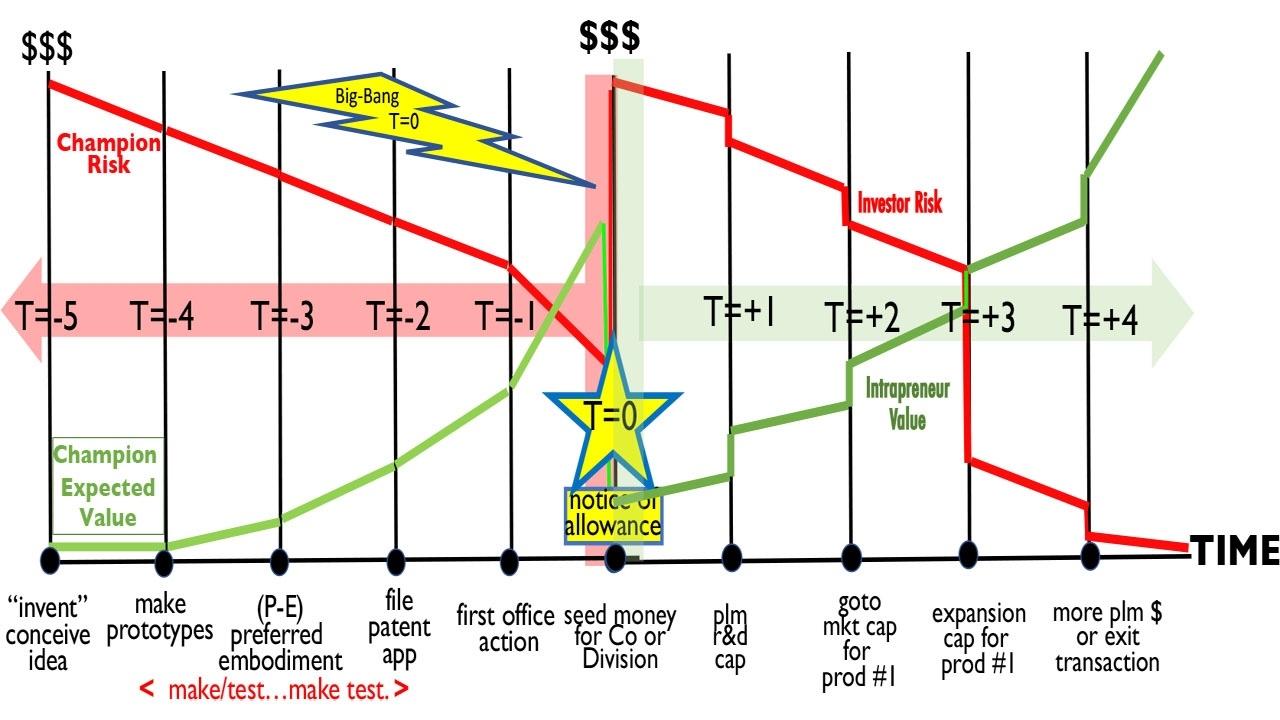
The BBT takes apart the sequence of events from conception to market exit, assigns time stamps to critical events, and identifies T=O as the instance when the "universe comes into being"...the notice of allowance. This simplification, allows Schwartz to take a look "backwards in time" from T=0 and disect the risk components related to achieving Sustainable Competitive Advantage (SCA) patent applications. As you will see, the greatest risk is from T=-4 to T=-2.
Often what's hard can be easy, and sometimes what should be easy is actually very hard. The single most important catalyst in making hard things easier is a problem solving angle, often called a Point of View (POV). If the right POV is used, then a problem can be dissolved or broken down into solvable components, that in line of a sensible sequence of events, results in "problem solved".
With IP, one of the more complex domains to secure patents with SCA ( Sustainable Competitive Advantage), I have adopted a unifying POV called...

